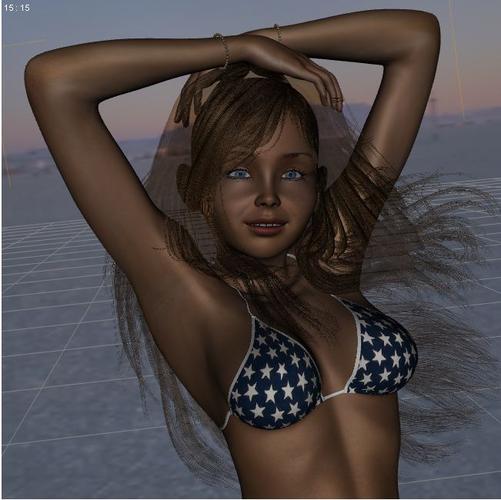Opacity question.
 deleted user
Posts: 1,204
deleted user
Posts: 1,204
Is there a way to disable this feature? I need to morph the hair, but its hard to see when it looks like this.


Capture.JPG
651 x 650 - 67K


Comments
Select the hair, go to the surface tab then go to the opacity and adjust it to however you want it. That also my be your transparency. You may need to adjust that as well.
It's at 100% Its the trans maps of the hair that's doing it.
It does not do that unless there is something behind it. Then it goes all weird.
Remove the background and set the background color to grey or white.
I... kinda need the background... lol
You can insert it again after posing the hair. Some backgrounds tend to make hair look like in your screenshot. The only way to avoid it is to remove it :-) But this strange effect is visible in the viewport only and does not affect your render. So after your hair is posed, insert the background again.
You can insert it again after posing the hair. Some backgrounds tend to make hair look like in your screenshot. The only way to avoid it is to remove it :-) But this strange effect is visible in the viewport only and does not affect your render. So after your hair is posed, insert the background again.
Yes am aware of this. Rendering as I type this. I was hoping it was a feature you can turn on and off.
I'm going to assume that you're using DAZ Studio, with a Genesis- or Genesis2-based figure. (If not, then all bets are off!) %-P
You could try morphing the hair before you apply the texture. In my set-up, when I load a hair object, it initially comes into the scene as an opaque, silver-gray figure (kind of like the default Genesis figure, only paler). Do your parenting, your posing, your morphing, and whatever.
Once you get it looking the way you want it, then you can select the hair, go to the Surfaces tab, and apply the texture. Click 'Render', see what happens, repeat as necessary....
Other than selecting a neutral-colored background (the earlier suggestion), that causes the hair to be more visible, that's all I can think of.
So, in other words, we have discovered a glitch. Not unique to me, Am I right?
I'm reluctant to call it a glitch; I see the same phenomenon when I'm working in Poser; once you apply a texture to it, the hair itself all but disappears. You can still see the effect you illustrated (a pretty much translucent, 'ghost' image of the hair), but even in full-on textured display mode (Poser has, like, nine different display options for the document window when you're editing -- from several varieties of wireframe, to cartoon-outline, to fully textured -- something I have yet to find in DS), it never shows you the actual hair.
I've always just put it down to a quirk of the display drivers, and just..., dealt with it. (Well, more like 'put up with it'.)
Technically one could call it a glitch, but this is a common issue due to the way programs use layer transparent objects over others. Generally speaking, translucent objects are drawn after the opaque ones so they can be properly blended, but to do this they're not depth-tested properly. Thus, when you get overlapping transparencies one overrides the other, giving you that funky effect.
There are ways to get around this issue, but the problem is they're much slower than the standard used, so most are willing to live with this minor issue for the significant performance boost.
Since this problem only appears in the viewport and the viewport is based on OpenGL it could also be a limitation with OpenGL.
OpenGL does not:
- display more than 8 lights at once
- display bump and displacement
- display shadows
- display transmapped items (like hair) correctly in front of some backgrounds
....
I still hope that some day the DAZ team will find a better coding for the viewport. Maybe in DAZ Studio 5 or 6 .... :-)
Poser 10/PoserPro 2014 have a much improved preview. The problem is that working out which surface of multiple overlapping transparency mapped surfaces is closest would be a significant slowing factor for the viewport - though it would be nice to have an option to pay that price if needed.
Of course, newer engines simply prioritize certain elements over others, which you can't really do in a viewport for a 3D design program like Daz Studio anyway. Okay, nerd time over. Back to rendering pictures of Lilith.